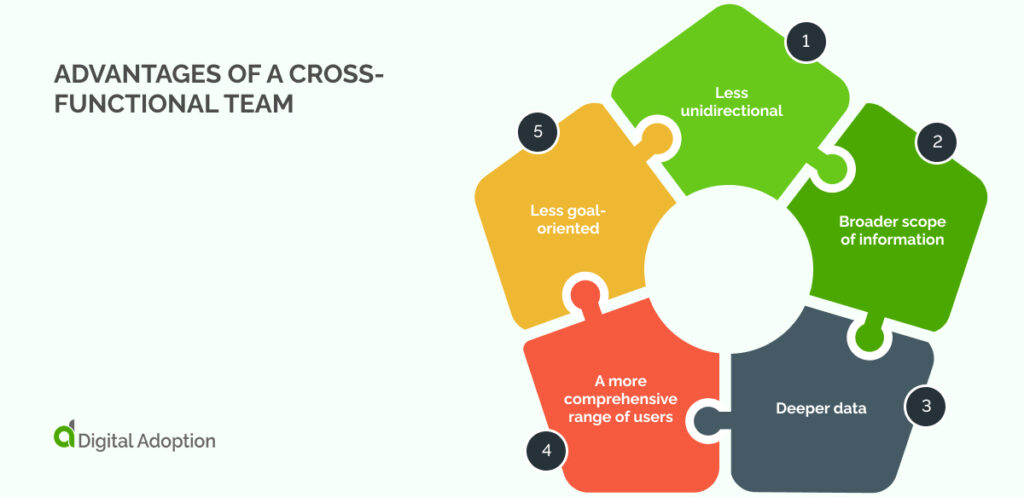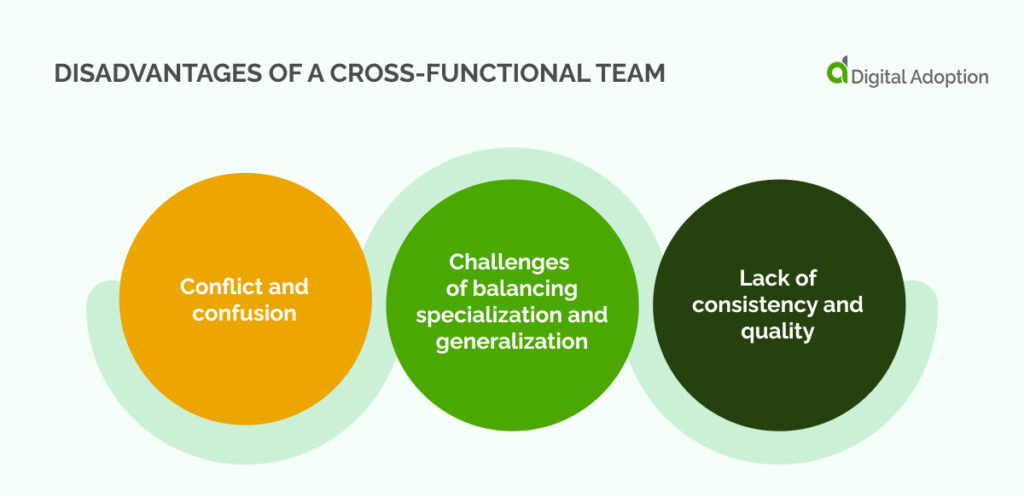Imagine the advantages to your organization if every department shared their learning and progressed using various skills to promote innovation and streamline their problem-solving via innovative workforce management.
These benefits are precisely what the cross-functional team attempts to achieve, as HR leaders build teams with a range of skills to strengthen their approach to problems using a variety of skill sets and experience to increase workforce agility toward large-scale disruption.
85% of workers say collaboration tools are one of the most critical focus areas. HR leaders must listen to these views and promote cross-departmental collaboration via multi-disciplinary cross-functional teams to achieve success.
To help you understand what a cross-functional team is, we will explore the differences between a functional team and a cross-functional team, examples of these teams, outcomes, and the advantages and disadvantages of this type of team.
What is a cross-functional team?
A cross-functional team, alternatively termed a multidisciplinary or interdisciplinary team, comprises individuals with diverse functional expertise collaborating to achieve a shared objective.
This group may involve professionals from various departments, such as finance, marketing, operations, and human resources, spanning all organizational levels. Additionally, team members may extend beyond the organization, including individuals from suppliers, key customers, or consultants.
What is the difference between a functional team and a cross-functional team?
You may be asking yourself what’s wrong with your current configuration as you build teams for specific purposes with expert staff holding skills relevant to their department.
Considering cross-functional teams when you compare them to the functional model can be helpful. Comparing the two can illuminate whether a cross-functional approach will benefit your organization. First, consider how a functional team works.
Functional teams
Functional teams are groups of people with similar skills or departments, such as marketing, finance, or software development. They have a clear leader and use their specialized expertise to perform their primary functions.
Cross-functional teams
Cross-functional teams are groups of people with diverse skills, backgrounds, or roles, such as product, project, or customer service teams. They have a specific goal, like launching a product, solving a problem, or improving a process. They can promote innovation, collaboration, and diversity.
The difference between functional and cross-functional teams
Functional:
Self-reliant members
Accessible communication
Low creativity and adaptability
Cross-functional:
Diverse, interdependent members
Challenging communication
Higher creativity and adaptability
Functional teams have similar and self-reliant members, while cross-functional teams have diverse and interdependent members. These differences affect their communication, coordination, creativity, and adaptability.
Functional teams have more accessible communication and coordination but lower creativity and adaptability. Cross-functional teams have more challenging communication and coordination but higher creativity and adaptability.
Consider the differences between functional and cross-functional teams when you decide how to use HR resources to build a cross-functional team to benefit your company.
3 examples of cross-functional teams
Cross-functional teams can be challenging to understand, so it’s helpful to look at examples of how enterprises have implemented them in the past to learn what has worked, what failed, and, crucially, why.
- Apple
Apple’s leadership model is different from the traditional autocratic model. Team members of all roles can endorse ideas, challenge opinions, and collectively refine their thinking for optimal solutions.
What they did
Apple’s commitment to enhancing the user experience extends beyond the surface. Teams responsible for streamlining product journeys through the supply chain and sales channels work cross-functionally with other Apple teams.
This team design allows each team member to discover ways to enhance processes, such as making it simple for consumers to order a product online and pick it up in a store.
Apple employed a cross-functional team to create the revolutionary iPhone. They brought together experts from different departments across the business to start what was to become a smartphone revolution.
Apple is globally renowned for its hardware, software, and services innovations. The fruits of this success are apparent, as Apple celebrated $394 billion in revenue in 2022.
What we can learn
There are many lessons HR leaders can take from Apple’s success in building cross-functional teams.
These lessons include:
- The leadership model is integral to a successful cross-functional team.
- Collaboration in a cross-functional team is more than teamwork; it involves passionate and collaborative discussions.
- Employees in different teams require the same principles, like respect and honesty, to form meaningful relationships.
- No team owns a product or service; many teams contribute to its success, and ownership is shared.
- Nokia
Nokia’s recruitment strategy favors candidates with experience leading or working within cross-functional teams across multiple locations. The company also embraces agile development principles in the day-to-day operations of its cross-functional teams.
What they did
Nokia Bell Labs’ executives championed cross-functionality by assembling scientists and engineers with distinct skill sets. This initiative cultivated a risk-tolerant organizational culture recognizing failure as a pivotal growth facet. This action led to the invention of the vacuum tube, a technology that revolutionized countless industries.
Today, Nokia remains a trailblazer in telecommunications technology, with its network infrastructure business achieving remarkable success. In June 2023, Nokia’s network infrastructure business achieved €10.0B in revenue, a 14% YoY growth.
What we can learn
Nokia was very successful with its implementation of cross-functional teams.
Here is what we can learn from their successes:
- The cross-functional team approach can increase the productivity of the entire business.
- Implementing cross-functional teams offers businesses an edge over competitors.
- Sharing information between teams can enhance the understanding and cooperation among different departments.
- Cross-functional teams can help the sales and finance teams work better together.
- Cisco
Cisco has transformed its organizational structure from a command and control system to a collaborative and organic work environment. Their HR strategy embraces lower-level manager input in top-level decision-making, nurturing a collaborative culture. This shift enables its teams and divisions to strategize collectively, facilitating sharing new product developments and technology across the organization.
What they did
Cisco’s cross-functional collaboration bears fruit, with the company being one of the top router security vendors in 2022. Their approach fuels the development of innovative devices with high product stickiness and enables them to introduce groundbreaking products to the market, outpacing competitors swiftly.
What we can learn
Cisco offers many lessons on what can make cross-functional teams successful.
These lessons include:
- Coss-functional teams adopt a multidirectional approach to collaboration.
- Several cross-functional teams can avoid rigid top-down or bottom-up models.
- This approach to team structure can ensure that ideas come from all levels of the organization, making everyone feel their views are valued.
- Cross-functional teams can foster engagement and innovation across the organization.
Advantages of a cross-functional team

There are many benefits to utilizing a cross-functional team in your organization. Knowing these benefits can help you decide whether to implement this approach within your future of work strategy. The first of these benefits is that teams with cross-functional capabilities become less unidirectional, allowing free movement of staff and ideas to avoid data silos.
Less unidirectional
Until the past few decades, decision-making followed a unidirectional flow, with one team making decisions for its direction and not sharing learning outcomes.
However, corporate-level goals steered strategic business unit (SBU) objectives, influencing functional-level objectives. Organizational structures are flatter, with reduced diversification and less defined functional departments.
The emergence of self-directed teams aligns with these shifts, promoting multi-directional intra-team dynamics over hierarchical structures. Interactive processes foster consensus, while directives to teams tend to be more general and less prescriptive.
Broader scope of information
For cross-functional teams, accessing diverse information is crucial for decision-making.
They must tap into the entire organizational information repository, incorporating data from all functional departments. System integration plays a vital role by ensuring all information is easily accessible through a unified interface.
A key advantage of cross-functional teams lies in the extensive knowledge each member contributes, representing their respective departments. This familiarity streamlines information retrieval, enhancing team efficiency by minimizing time spent on data gathering.
Deeper data
Cross-functional teams necessitate information spanning all management levels, originating from the perceived necessity to make strategic, tactical, and operational decisions. These teams, often self-directed, amalgamate traditionally distinct types of information.
For instance, new product development, typically a tactical process, receives strategic direction from top management and utilizes operational departments like engineering and marketing.
Regardless of focus, the team requires information associated with all three decision-making levels, showcasing its multifaceted information needs.
A more comprehensive range of users
Cross-functional teams comprise individuals from diverse organizational areas, requiring information to be accessible to all team members.
Technical, financial, and marketing data, among others, should be presented in a universally understandable format, acknowledging that technical data isn’t exclusive to engineers, financial data to accountants, or HR data to human resources personnel.
Without middle managers for data processing, organizations must streamline information for cross-functional teams.
The process of streamlining information for cross-functional teams involves the following steps:
- Minimizing specialized jargon.
- Prioritizing information.
- Concealing complex statistical procedures.
- Offering result interpretations.
- Providing clear explanations.
Data visualization systems play a crucial role in presenting intricate results intuitively, facilitating better comprehension.
Less goal-oriented
Since Peter Drucker’s 1954 book The Practice of Management published his views on management by objectives, business decision-making has become more goal-oriented.
Managers have come to view decision-making generally, and strategic thinking in particular, as a multi-stage process that starts with assessing the current situation, defining objectives, and then determining how to reach these objectives. Management by objectives applied this basic scheme to virtually all significant decisions.
Cross-functional teams, using unstructured techniques and searching for revolutionary competitive advantages, allegedly require information systems featuring increased interactivity, more flexibility, and the capability of dealing with fuzzy logic. Artificial intelligence may one day be helpful in this aspect.
Disadvantages of a cross-functional team

Although there are many advantages to using the cross-functional team structure, there are also disadvantages. One of the first is that they can cause conflict and confusion throughout the organization. Consider these disadvantages to ensure a cross-functional approach is suitable for your enterprise.
Conflict and confusion
Cross-functional teams have some challenges and risks that HR leaders must know. One challenge is that they can cause conflict and confusion in the organization if other stakeholders and managers do not align, coordinate, and support them.
Challenges of balancing specialization and generalization
Another challenge is that cross-functional teams need to balance specialization and generalization. Team members must have deep and broad skills and knowledge to do their roles well.
Lack of consistency and quality
A third challenge is that cross-functional teams must maintain quality, consistency, and standards. They must use different tools, processes, and expectations from different functions and customers.
Share learning with a cross-functional approach
Cross-functional teams are people with different skills, roles, and backgrounds who work together towards a common goal. They can share learning and knowledge across disciplines, departments, and functions.
Doing so allows them to promote the acceleration of innovation and transformation through collaboration and diversity in their organizations.
Share learning with a cross-functional approach today for a more diverse, innovative organization and a more prosperous, collaborative culture and workforce.






![18 Examples of AI in Finance [2025]](https://www.digital-adoption.com/wp-content/uploads/2025/06/18-Examples-of-AI-in-Finance-2025-300x146.jpg)
![14 Examples of AI in Manufacturing [2025]](https://www.digital-adoption.com/wp-content/uploads/2025/06/14-Examples-of-AI-in-Manufacturing-2025-300x146.jpg)
![29 Examples of AI in Education [2025]](https://www.digital-adoption.com/wp-content/uploads/2025/06/29-Examples-of-AI-in-Education-2025-300x146.jpg)




![18 Examples of AI in Finance [2025]](https://www.digital-adoption.com/wp-content/uploads/2025/06/18-Examples-of-AI-in-Finance-2025.jpg)